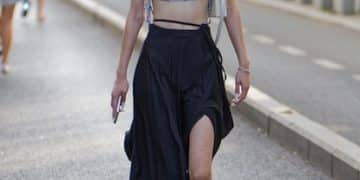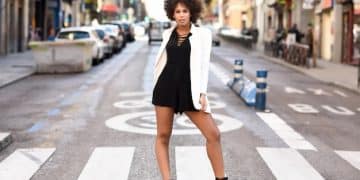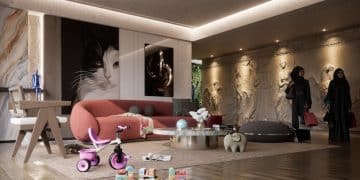Dress Your Body Type: Flattering Outfit Ideas for Every Shape and Size
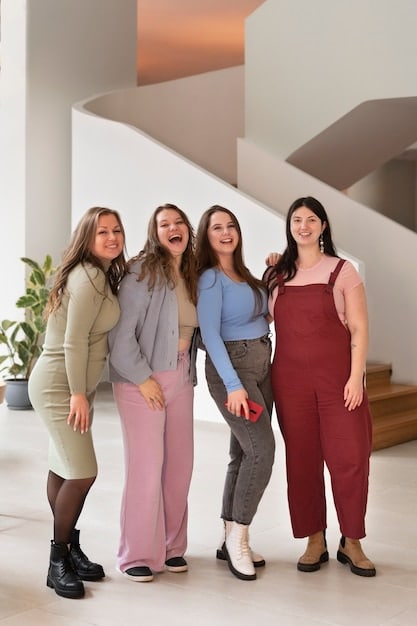
Anúncios
Achieving a flattering look involves understanding your unique body shape, a timeless approach to fashion that enhances natural beauty and boosts confidence by highlighting strengths and balancing proportions through strategic clothing choices and versatile outfit solutions.
Understanding how to dress your body type: flattering outfit ideas for every shape and size is more than just following trends; it’s about embracing your unique silhouette and choosing pieces that celebrate it. This guide delves into key principles and practical tips to help you build a wardrobe that makes you feel confident and stylish, no matter your shape or size.
Understanding Your Unique Body Shape
Before diving into specific outfit recommendations, it’s essential to identify your body shape. This isn’t about fitting into a rigid category, but rather about recognizing your natural proportions to better understand which clothing styles will complement them most effectively. Most body shapes fall into a few general categories, each with distinct features that can be accentuated or balanced through strategic dressing.
Recognizing your body shape allows you to make informed decisions about cuts, fabrics, and patterns. It’s not about hiding or altering your body; it’s about enhancing its natural beauty and leveraging clothing as a tool for self-expression and confidence. This foundational knowledge empowers you to select garments that drape beautifully, highlight your favorite features, and create a harmonious overall look.
Common Body Shapes Explained
While everyone is unique, most figures can be broadly categorized to simplify styling advice. These categories provide a helpful framework for understanding how different clothing items will sit on your frame. It’s crucial to remember that these are guidelines, not strict rules.
- Apple Shape: Characterized by a fuller midsection, broader shoulders, and slender legs and arms. The goal is often to draw attention to the legs and arms while creating a more defined waistline.
- Pear Shape: Features wider hips and thighs compared to the bust and shoulders, with a defined waist. Emphasizing the upper body and creating balance with the lower half is key.
- Hourglass Shape: Defined by a well-proportioned bust and hips with a narrow, defined waist. This shape benefits from styles that highlight the natural curves.
Understanding these basic distinctions helps in navigating the vast world of fashion. It allows for a more personalized approach to shopping and styling, ensuring that each piece you choose truly works for you. The aim is always to create visual balance and enhance your proportions in a way that feels comfortable and authentic to your personal style.
Flattering Fashion Principles for Every Body
Regardless of your specific body shape, certain fashion principles apply universally to create flattering outfits. These principles revolve around understanding proportion, balance, and how different cuts and fabrics interact with your silhouette. Applying these guidelines can transform your wardrobe, making every outfit feel more intentional and polished.
The core idea is to create visual harmony. This might involve drawing attention to your favorite features, elongating your frame, or bringing balance to your overall silhouette. By mastering these principles, you move beyond simply wearing clothes to truly dressing and styling your body in a way that is both flattering and expressive.
The Power of Proportion and Balance
Proportion refers to the relationship of parts to the whole, while balance is about creating visual equilibrium. In fashion, this means distributing visual weight evenly or strategically to create an appealing outline. For instance, if you have broader shoulders, balancing them with wider hemlines can create a more harmonious look.
- Vertical Lines: Maximize length with vertical stripes, open cardigans, or long necklaces. These draw the eye up and down, creating an illusion of height.
- Horizontal Lines: Can add width where desired, such as to narrow shoulders or hips. Use them strategically to balance proportions.
- Color Blocking: Strategic use of color can create illusions. Darker colors tend to recede, while lighter colors highlight and bring forward.
Fabrics also play a crucial role. Stiffer fabrics hold their shape and can add structure, while softer, drapier fabrics flow and can soften angles or conceal areas. Understanding how different textures and weights behave on your body is just as important as the cut of the garment. This knowledge allows you to select pieces that not only fit well but also complement your natural form beautifully.
Styling Tips for Apple Shapes
For those with an apple body shape, the focus is often on elongating the torso, creating a defined waistline, and highlighting the slender legs and arms. The goal is to draw attention upwards and downwards, moving the eye away from the midsection and creating an overall balanced silhouette that celebrates your assets.
When selecting garments, think about styles that offer structure without being restrictive around the waist. Flowy tops, empire-waist dresses, and well-fitted bottoms can work wonders. Avoid anything that adds bulk to your midsection or is too tight, as this can emphasize areas you might prefer to de-emphasize. The right styling choices can make a significant difference in how you feel and look.
Key Pieces for Apple Shapes
Choosing the right garments can transform your look and enhance your confidence. The right cuts and styles can create a harmonious silhouette, emphasizing your best features while offering comfort and style. Focus on pieces that offer definition without constriction around the middle.
- Empire Waist Dresses and Tops: These styles cinch just below the bust, flowing gracefully over the midsection, making them incredibly flattering.
- A-Line Skirts and Dresses: The gradual flare from the waist or hips helps to balance the upper body and create a lovely silhouette.
- V-Neck or Scoop Necklines: These necklines draw attention upwards towards your décolletage and face, elongating the neck and torso.
Pairing these tops and dresses with slim or straight-leg pants can further enhance the look, drawing attention to your slender legs. Accessories like long necklaces can also help create vertical lines, adding to the illusion of length and streamlining the figure. It’s all about strategic styling that celebrates your natural shape and makes you feel fantastic.
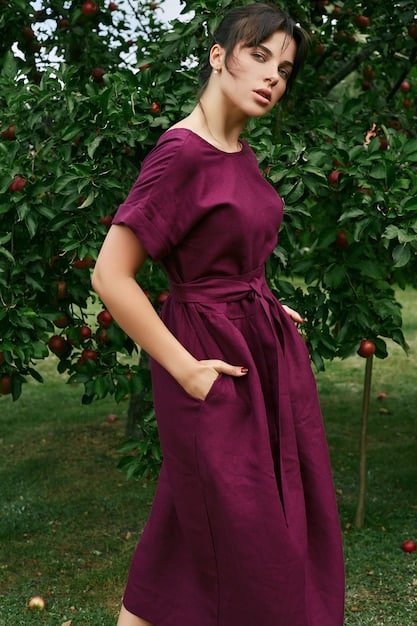
Outfit Ideas for Pear Shapes
For individuals with a pear body shape, the aim is typically to balance the wider hips and thighs with the narrower bust and shoulders. This can be achieved by drawing attention upwards, adding volume to the upper body, and choosing bottoms that skim over the lower curves without adding bulk.
Creating visual balance is paramount. Think about bright colors, bold patterns, and interesting necklines for your tops. For bottoms, darker colors and clean lines work best to create a streamlined look. The right combinations can create a beautifully symmetrical silhouette, enhancing your natural proportions and boosting your style confidence.
Flattering Styles for Pear Shapes
Strategic clothing choices can beautifully highlight your assets and create desired proportions. The goal is to broaden the appearance of the shoulders and bust while gently skimming over the hips and thighs. This creates an optical illusion of balance and harmony.
- Structured Tops and Blouses: Pieces with padded shoulders, ruffles, or embellishments at the neckline can add volume and draw the eye upwards.
- A-Line Skirts and Dresses: These naturally flare out from the waist, gracefully gliding over the hips and thighs without clinging, providing an elegant silhouette.
- Bootcut or Flare Pants: The slight flare at the bottom balances the width of the hips, creating a more cohesive and elongated look for the legs.
When choosing trousers or jeans, opt for styles with subtle distressing or detailing on the upper thigh if you wish, but generally, a clean, dark wash is most flattering. Avoid overly busy pockets or embellishments on the hips, as these can add unwanted visual weight. Focusing on pieces that enhance your upper body while providing sleek lines for your lower half will always yield a stylish and flattering outcome.
Dressing for Hourglass Figures
For those with an hourglass body shape, the key is to highlight your naturally defined waistline while embracing the balanced proportions of your bust and hips. This shape is often considered ideal for its natural curves, making it easy to find clothes that celebrate your figure without feeling restrictive.
The best way to showcase an hourglass figure is to choose clothing that cinches at the waist. Avoid shapeless or boxy items that conceal your natural curves, as these can make your frame appear larger than it is. Instead, opt for pieces that follow your body’s natural contours, emphasizing your unique silhouette and enhancing your confidence.
Optimal Clothing Choices for Hourglass Shapes
Emphasizing the waist is crucial for the hourglass figure, as it accentuates the natural curves and creates a polished, flattering look. Styles that contour the body without being overly tight work best. The goal is to celebrate your proportions with well-fitting and elegant garments.
- Wrap Dresses and Tops: These are custom-made for the hourglass figure, cinching beautifully at the waist and draping gracefully over the bust and hips.
- Tailored Skirts (Pencil or A-line): Pencil skirts emphasize curves, while A-line skirts provide a subtle flare that maintains balance without adding bulk. Both work well when paired with a fitted top.
- High-Waisted Bottoms: Jeans, pants, and skirts that sit at your natural waist effectively highlight your slimmest part and elongate the legs.
When it comes to necklines, V-necks and scoop necks are particularly flattering as they enhance the bust without adding unnecessary volume. Avoid excessively loose or oversized clothing that can hide your waist, as this negates the natural balance of your shape. Fabric choice is also important; opt for materials that have some stretch or drape well to accommodate your curves comfortably.
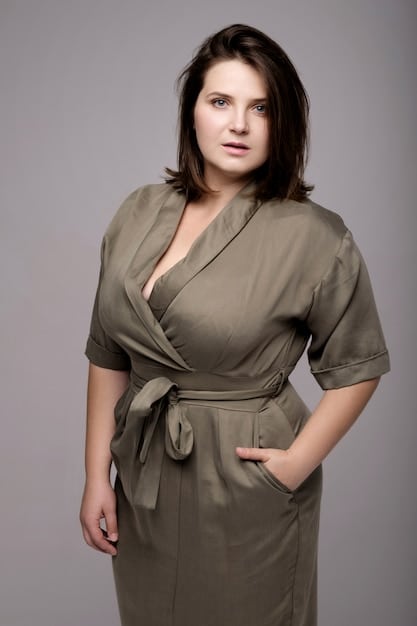
Styling Strategies for Rectangle Shapes
Individuals with a rectangle body shape typically have shoulders, waist, and hips that are roughly the same width, creating a straight up-and-down silhouette. The goal when dressing this body type is to create the illusion of curves and add definition to the waist, breaking up the straight line and enhancing visual interest.
To achieve this, focus on clothing that adds volume to the upper and lower body, while creating a cinched effect at the waist. This can involve strategic layering, choosing textured fabrics, and using accessories to define your midsection. The right clothing choices can transform a straight silhouette into a more curvaceous and dynamic one, adding depth and dimension to your outfits.
Creating Curves for Rectangle Shapes
The art of dressing a rectangle shape lies in adding strategic volume and creating the illusion of a defined waist. This involves using clothing to build shape and proportion where desired, resulting in a more curvaceous and appealing silhouette. The key is to select items that break up the straight lines of the body subtly yet effectively.
- Belts: Cinching a belt around your natural waist over dresses, tunics, or even blazers is the simplest and most effective way to create an hourglass illusion.
- Peplum Tops and Jackets: The flared detail at the waist adds volume to the hips and defines the waist simultaneously, creating a flattering contrast.
- Ruffles and Embellishments: Tops with ruffles, bows, or creative detailing on the bust or shoulders can add volume to the upper body, balancing the silhouette.
When choosing bottoms, opt for styles that add volume, such as pleated skirts, A-line skirts, or wide-leg pants. These can create the appearance of fuller hips, further enhancing the illusion of a defined waist when paired with tops or dresses cinched at the midsection. Experiment with different textures and layers to add dimension to your outfits, making them more dynamic and visually interesting.
The Role of Accessories in Flattering Your Figure
Accessories are not mere afterthoughts; they are powerful tools that can significantly enhance an outfit and flatter your body shape. From statement necklaces to belts and shoes, each accessory plays a part in directing the eye, adding visual interest, and refining your overall silhouette. Understanding how to use them effectively can elevate even the simplest ensemble.
Strategic accessorizing allows you to highlight your best features and create balance. A well-placed belt can define a waist, while a statement necklace can draw attention to your décolletage and face. These small additions can make a huge impact on how an outfit looks and feels on your body, completing your look with finesse.
Strategic Accessorizing for Impact
Accessories serve as powerful amplifiers for your outfits, not just as decorative elements. Used wisely, they can draw attention to your best features, strategically shift focus, and add that crucial element of balance to your overall silhouette. Thinking of them as an extension of your clothing rather than merely adornments can transform your approach to styling.
- Belts: The ultimate waist-definer. A wide belt can cinch in a loose dress, creating an hourglass shape, while a skinny belt can subtly highlight a narrow waist without overpowering it.
- Statement Necklaces: Draw attention upwards towards your face and décolletage. This is especially effective for balancing broader hips or for apple shapes looking to elongate the torso.
- Scarves: Can add vertical lines when worn long and flowing, or add volume and interest to the upper body when draped around the neck or shoulders.
Shoes also play a critical role; pointed-toe shoes can elongate the leg, while chunkier heels can balance broader calves or hips. Handbags, too, can influence your silhouette. For example, a structured bag held at the hip might add volume, whereas a cross-body bag could create a diagonal line that flatters. The key is to see accessories as part of the overall design strategy, utilizing them to enhance your body’s natural lines and create the desired visual effect, ensuring every element of your outfit works in harmony.
Beyond Body Type: Embracing Personal Style and Comfort
While understanding your body type is a fantastic starting point for building a flattering wardrobe, true style goes beyond categorizing shapes. It’s about merging these insights with your personal aesthetic, your comfort level, and the confidence that comes from feeling authentically yourself in what you wear. Fashion should be a tool for self-expression, not a restrictive set of rules.
Your unique style is a reflection of your personality, values, and how you want to present yourself to the world. It involves experimenting with trends, colors, and textures that resonate with you, even if they don’t perfectly align with traditional body-type recommendations. Ultimately, the most flattering outfit is one that makes you feel incredible, allowing your inner radiance to shine through effortlessly.
The Interplay of Fit, Fabric, and Confidence
The perfect outfit isn’t just about the cut; it’s a harmonious blend of fit, fabric, and the unshakable confidence you feel when wearing it. While a garment might be designed for a specific body type, if it doesn’t fit well or feels uncomfortable, its potential to flatter is diminished. The way a fabric drapes and moves with your body is as crucial as its initial silhouette. A well-fitting garment, regardless of its ‘ideal’ body type, will always look better than something ill-fitting. The fabric’s texture, weight, and elasticity can drastically alter a garment’s appearance on your body, either enhancing or detracting from your shape. Moreover, when you feel comfortable, that ease translates into confident posture and movement, which is the ultimate style statement. Therefore, prioritize trying on clothes, assessing how they feel and move, and ensuring they allow you to go about your day with ease. Don’t be afraid to make alterations; a small tweak can transform a good piece into a great one. Comfort underpins confidence.
- Fit is paramount: Even the most perfect “body type” garment will look off if it’s too tight or too loose. Pay attention to how clothes sit on your shoulders, waist, and hips. Alterations can make a significant difference.
- Fabric choice matters: Drapier fabrics like rayon or silk can flatter curves, while structured materials like stiffer cottons or wool can add shape. Consider how the fabric feels against your skin and how it moves.
- Confidence is the ultimate accessory: No matter what you wear, if you feel good in it, you will exude confidence, which is genuinely the most attractive quality.
Ultimately, dressing for your body type is a guide, not a rigid set of instructions. Use these insights to inform your choices, but always remember to prioritize what makes you feel good and expresses who you are. Fashion should be fun and empowering, allowing you to experiment and evolve your style over time, always with comfort and self-expression at its heart. Embrace your unique beauty and wear what brings you joy.
| Key Point | Brief Description |
|---|---|
| 🍎 Body Shape Recognition | Identify your unique silhouette to choose complementary styles that enhance your natural proportions and confidently express your individuality. |
| 📏 Proportion & Balance | Apply principles of vertical lines, color blocking, and fabric choice to create visual harmony and a symmetrical, flattering look for any body type. |
| ✨ Strategic Accessorizing | Use belts, necklaces, and scarves to define the waist, draw attention upward, and balance proportions, enhancing overall outfit appeal. |
| 💖 Personal Style & Comfort | Beyond guidelines, prioritize fit, feel, and confidence for authentic self-expression, ensuring your outfit makes you feel comfortable and radiant. |
Frequently Asked Questions About Dressing Your Body Type
To identify your body type, stand in front of a mirror in form-fitting clothing. Observe the relationship between your shoulders, bust, waist, and hips. Take measurements if needed. Compare these proportions to common shapes like hourglass, apple, pear, or rectangle to find the closest match. Remember, these are guidelines to help, not strict definitions.
Absolutely! The goal of understanding body types is to guide, not restrict. You can adapt trends by selecting versions that incorporate flattering elements, or by pairing them with pieces that balance your proportions. Personal style and confidence are paramount, so always prioritize what makes you feel great, even if it’s a trend.
Common mistakes include wearing overly baggy clothes that hide curves, choosing ill-fitting garments (either too tight or too loose), or ignoring their waistline. Another error is strictly adhering to rules without considering personal preference or comfort. Fashion should enhance, not conceal, your natural figure, and confidence always shines through well-fitting attire.
Fabrics and patterns can significantly influence an outfit’s flattery. Stiffer fabrics add structure, while softer ones drape to soften lines. Medium to large patterns can add volume, while small repetitive patterns generally don’t. Horizontal stripes can widen, and vertical stripes can lengthen. Using these elements strategically helps create desired proportions and visual interest.
Yes, body types can subtly change due to factors like age, weight fluctuations, hormonal shifts, and lifestyle changes. While your basic skeletal structure remains constant, the distribution of weight can shift, altering your proportions. It’s a good idea to periodically re-evaluate your body shape to ensure your clothing choices remain the most flattering.
Conclusion
Mastering how to dress your body type is an empowering journey that redefines your relationship with fashion. It’s not about conforming to ideals, but rather understanding and celebrating your unique physique by making informed choices about fit, fabric, and silhouette. By embracing these principles, you unlock a wardrobe that not only flatters your figure but also amplifies your confidence and personal style, ensuring you always feel your best.



